October 19, 2010
Relevance Vector Machines Explained
Tristan Fletcher
www.cs.ucl.ac.uk/staff/T.Fletcher/
�
Introduction
This document has been written in an attempt to make Tipping’s [1] Rele-
vance Vector Machines (RVM) as simple to understand as possible for those
with minimal experience of Machine Learning.
It assumes knowledge of
probability in the areas of Bayes’ theorem and Gaussian distributions in-
cluding marginal and conditional Gaussian distributions.
It also assumes
familiarity with matrix differentiation, the vector representation of regres-
sion and kernel (basis) functions. These latter two areas are briefly covered
in the author’s similar paper on Support Vector Machines which can be
found through the URL on the coverpage.
The document has been split into two main sections. The first introduces the
problem that needs to be solved, namely maximising the posterior probabil-
ity of regression target values over some hyperparameters. It then proceeds
to derive the equations required to do this. Aside from the areas mentioned
above where knowledge is assumed, every mathematical step is gone through.
It is therefore hoped that there is no ambiguity over any of the details in
this explanation, though this does make the description a little cumbersome.
The second section therefore explains from an algorithmic viewpoint the it-
erations that would be required to actually apply the technique.
Aside from Tipping [1], the majority of this document is based on work by
MacKay [2], [3], [4], [5] and Bishop [6].
Notation
With the view of making this description as explicit (in the mathematical
sense) as possible, it is worth introducing some of the notation that will be
used:
• P (A|B, C) is the probability of A given B and C. Note that using
this notation, different representations of the parameters will not alter
this probability, e.g. P (A|B) ≡ P (A|B−1). Furthermore, for the sake
of simplicity, occasionally some of the elements in the probabilistic
notation will be omitted where they are not relevant, e.g. P (A|B) ≡
P (A|B, C, D etc).
• X ∼ N (µ, σ2) is used to signify that X is normally distributed with
mean µ and variance σ2.
• Bold font is used to represent vectors and matrices.
1
�
1 Theory
1.1 Evidence Approximation Theory
Linear regression problems are generally based on finding the parameter
vector w and the offset c so that we can predict y for an unknown input
x (x ∈ M ):
y = wT x + c
In practice we usually incorporate the offset c into w. If there is a non-linear
relationship between x and y then a basis function can be used:
y = wT φ(x)
where x → φ(x) is a non-linear mapping (i.e. basis function).
When attempting to calculate w from our our training examples, we as-
sume that each target ti is representative of the true model yi, but with the
addition of noise �i:
ti = yi + �i
= wT φ(xi) + �i
where �i are assumed to be independent samples from a Gaussian noise
process with zero mean and variance σ2, i.e. �i ∼ N (0, σ2) ∀i . This means
that:
P (ti|xi, w, σ2) ∼ N (yi, σ2)
= (2πσ2)− 1
2 exp
= (2πσ2)− 1
2 exp
− 1
2σ2 (ti − yi)2
− 1
2σ2 (ti − wT φ(xi))2
Looking at N training points simultaneously, so that the vector t represents
all the individual training points ti and the N × M design matrix Φ is
constructed such that the ith row represents the vector φ(xi), we have:
N
N
i=1
P (t|xi, w, σ2) =
=
N (wT φ(xi), σ2)
(2πσ2)− 1
2 exp
i=1
= (2πσ2)− N
2 exp
− 1
2σ2 (ti − wT φ(xi))2
− 1
2σ2 t − Φw2
2
�
When attempting to learn the relationship between x and y, we wish to
constrain complexity and hence the growth of the weights w and do this
by defining an explicit prior probability distribution on w. Our preference
for smoother and therefore less complex functions is encoded by using a
zero-mean Gaussian prior over w:
P (w|αi) ∼ N (0, α−1
i )
where we have used αi to describe the inverse variance (i.e. precision) of
each wi. If once again we look at all N points simultaneously, so that the
ith element in the vector α represents αi, we have:
N
P (w|α) =
N (0, α−1
i )
i=0
This means that there is an individual hyperparameter αi associated with
each weight, modifying the strength of the prior thereon.
The posterior probability over all the unknown parameters, given the data,
is expressed as P (w, α, σ2|t). We are trying to find the w, α and σ2 which
maximise this posterior probability. We can decompose the posterior:
P (w, α, σ2|t) = P (w|t, α, σ2)P (α, σ2|t)
(1.1)
Substituting β−1 for σ2 to make the maths appear less cluttered, the first
part of (1.1) can be expressed:
P (w|t, α, β) ∼ N (m, Σ)
(1.2)
where the mean m and the covariance Σ are given by:
m = βΣΦT t
Σ = (A + βΦT Φ)−1
and A = diag(α).
(1.3)
(1.4)
The method for arriving at (1.2), (1.3) and (1.4), relating to conditional
Gaussian distributions, lies outside the scope of this document.
In order to evaluate m and Σ we need to find the hyperparameters (α and
β) which maximise the second part of (1.1), which we decompose:
P (α, σ2|t) ∝ P (t|α, σ2)P (α)P (σ2)
We will assume uniform hyperpriors and hence ignore P (α) and P (σ2). Our
problem is now to maximise the evidence:
P (t|α, σ2) ≡ P (t|α, β) =
P (t|w, β)P (w|α)dw
(1.5)
3
�
Looking at the first component of the equation:
P (t|w, β) =
=
N (y, β−1)
− N
2
exp
t − Φw2
− β
2
(1.6)
And then at the second (where M is the dimensionality of x):
N
2π
i=1
β
M
M
i=1
P (w|α) =
=
N (0, α−1
i )
αiw2
− 1
2
− 1
2
α
i exp
wT Aw
(2πα−1
2 exp
i )− 1
M
1
2
i=1
i=1
= (2π)− M
2
Substituting (1.6) and (1.7) into (1.5):
− N
2π
N
β
2 1
β
2
M
M
2
− β
2
exp
2π
2π
i=1
β
2
t − Φw2
(2π)− M
2
1
2
i
α
exp−
P (t|α, β) =
=
(1.7)
− 1
2
1
2
i exp
α
M
i=1
dw
wT Aw
dw
t − Φw2 +
wT Aw
1
2
(1.8)
In order to simplify (1.8), we create a definition to represent the integrand:
E(w) =
β
2
t − Φw2 +
1
2
wT Aw
(1.9)
This means that:
P (t|α, β) =
β
2π
2 1
N
M
2
2π
M
i=1
1
2
i
α
exp{−E(w)} dw
Expanding out (1.9) we get:
E(w) =
=
β
2
1
2
(tT t − 2tT Φw + wT ΦT Φw) +
(βtT t − 2βtT Φw + βwT ΦT Φw + wT Aw)
wT Aw
1
2
4
�
Substituting in (1.4) and then using I = Σ−1Σ:
E(w) =
=
1
2
1
2
(βtT t − 2βtT Φw + wT Σ−1w)
(βtT t − 2βtT ΦΣ−1Σw + wT Σ−1w)
Substituting in (1.3):
E(w) =
1
2
(βtT t − 2mT Σ−1w + wT Σ−1w + mT Σ−1m − mT Σ−1m)
= E(t) +
1
2
(w − m)T Σ−1(w − m)
where
E(t) =
(βtT t − mT Σ−1m)
1
2
Our integrand from (1.8) now becomes:
exp{−E(w)} dw = exp{−E(t)} (2π)
M
2 |Σ| 1
2
Substituting this back in, gives us:
β
2 1
N
M
2
2π
2π
M
i=1
1
2
i exp{−E(t)} (2π)
α
M
2 |Σ| 1
2
P (t|α, β) =
This is known as our marginal likelihood and taking logs, gives us our log
marginal likelihood :
M
i=1
ln P (t|α, β) =
N
2
ln β − E(t) − 1
2
ln|Σ| − N
2
ln(2π) +
1
2
ln αi (1.10)
It is this equation we need to maximise with respect to α and β, a process
known as the evidence approximation procedure.
1.2 Evidence Approximation Procedure
In order to maximise our log marginal likelihood, we start by taking deriva-
tives of (1.10) with respect to αi and setting these to zero:
ln P (t|α, β) =
d
dαi
1
2αi
⇒ αi =
Σii − 1
− 1
2
2
1 − αiΣii
m2
i = 0
m2
i
5
�
Substituting in γi = 1 − αiΣii our recursive definition for the αi which
maximise (1.10) can be expressed more elegantly as:
αi =
γi
m2
i
We now need to differentiate (1.10) with respect to β and set these deriva-
tives to zero:
N
β
− t − Φm2 − T rΣΦT Φ
ln P (t|α, β) =
d
dβ
1
2
= 0
(1.11)
In order to solve this, we first simplify the argument of the trace operator
T r[•]:
ΣΦT Φ = ΣΦT Φ + β−1ΣA − β−1ΣA
= ΣΦT Φβ + A β−1 − β−1ΣA
=A + βΦT Φ−1ΦT Φβ + A β−1 − β−1ΣA
= (I − AΣ) β−1
Substituting this back into (1.11):
I − AΣ
= 0
β
= t − Φm2
− t − Φm2 − T r
I − AΣ
− T r
β
(N − T r [I − AΣ]) = t − Φm2
N
1
2
β
⇒ N
β
⇒ 1
β
⇒ 1
β
=
N − T r [I − AΣ]
t − Φm2
N −
i γi
t − Φm2
⇒ β =
The αi and β which maximise our marginal likelihood are then found it-
eratively by setting α and β to initial values, finding values for m and Σ
from (1.3) and (1.4), using these to calculate new estimates for α and β and
repeating this process until a convergence criteria is met.
We will then be left with values for α and β which maximise our marginal
likelihood and which we can use to evaluate our predictive distribution over
t for a new input x:
P (t|x, α, β) =
P (t|w, β)P (w|, α, β)dw
= N (mT φ(x), σ2(x))
6
�
This means that our estimate for t is the mean of the above distribution
mT φ(x).
Our confidence in our prediction is determined by the variance of this dis-
tribution σ2(x) which is given by:
σ2(x) = β−1 + φ(x)T Σφ(x)
1.3 Automatic Relevance Determination
Whilst carrying out the evidence approximation procedure described above,
many of the αi will tend to infinity. This has implications for the variance
Σ and mean m of the posterior distribution over the corresponding weights
in (1.2):
lim
αi→∞ Σ = lim
⇒ lim
αi→∞ m = lim
αi→∞(A + βΦT Φ)−1 = 0
αi→∞ βΣΦT t = 0
This means that each wi that such αi relate to will be distributed αi ∼
N (0, 0), i.e. will be equal to zero. The corresponding basis functions, φ(xi)
should therefore be pruned from the overall design matrix Φ each iteration.
The xi corresponding to the remaining non-zero weights after pruning are
called relevance vectors and are analogous to the support vectors of an SVM.
7
�
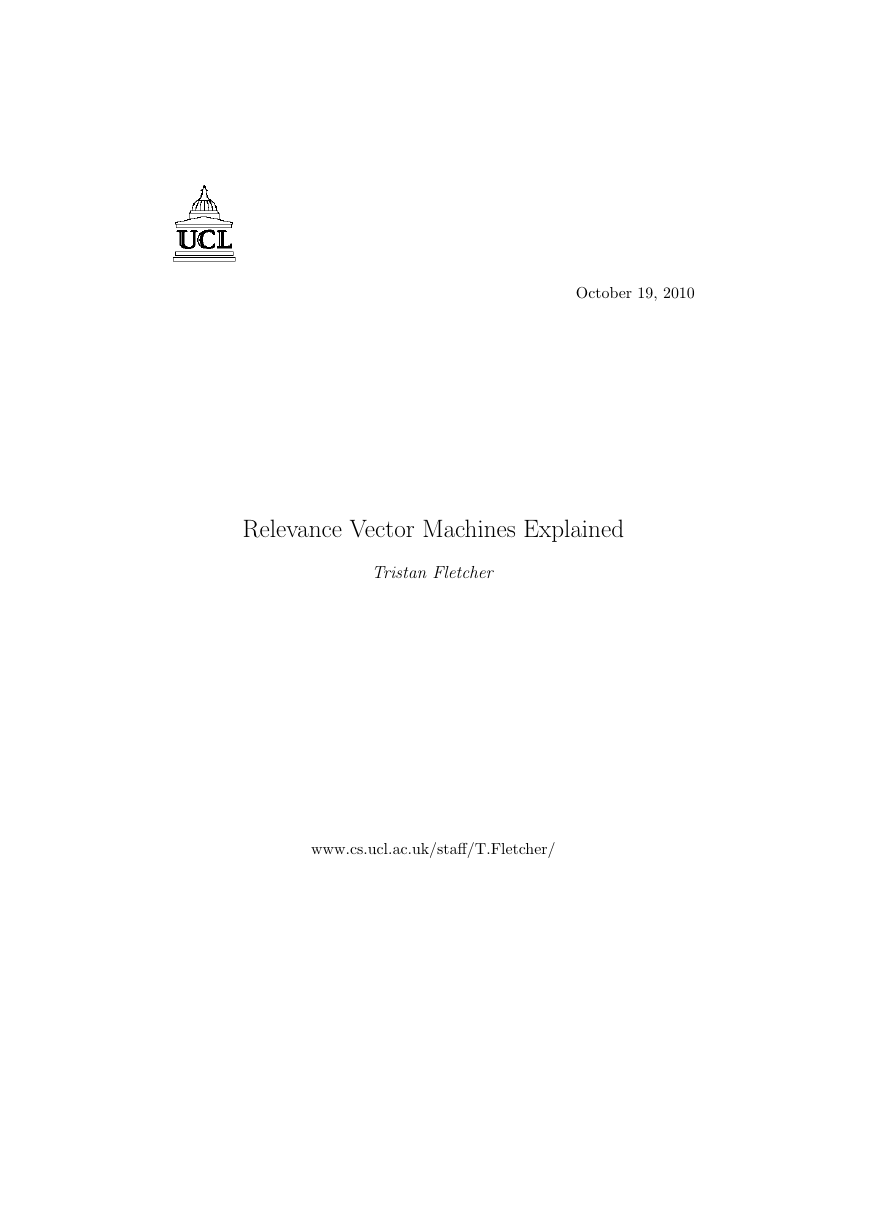
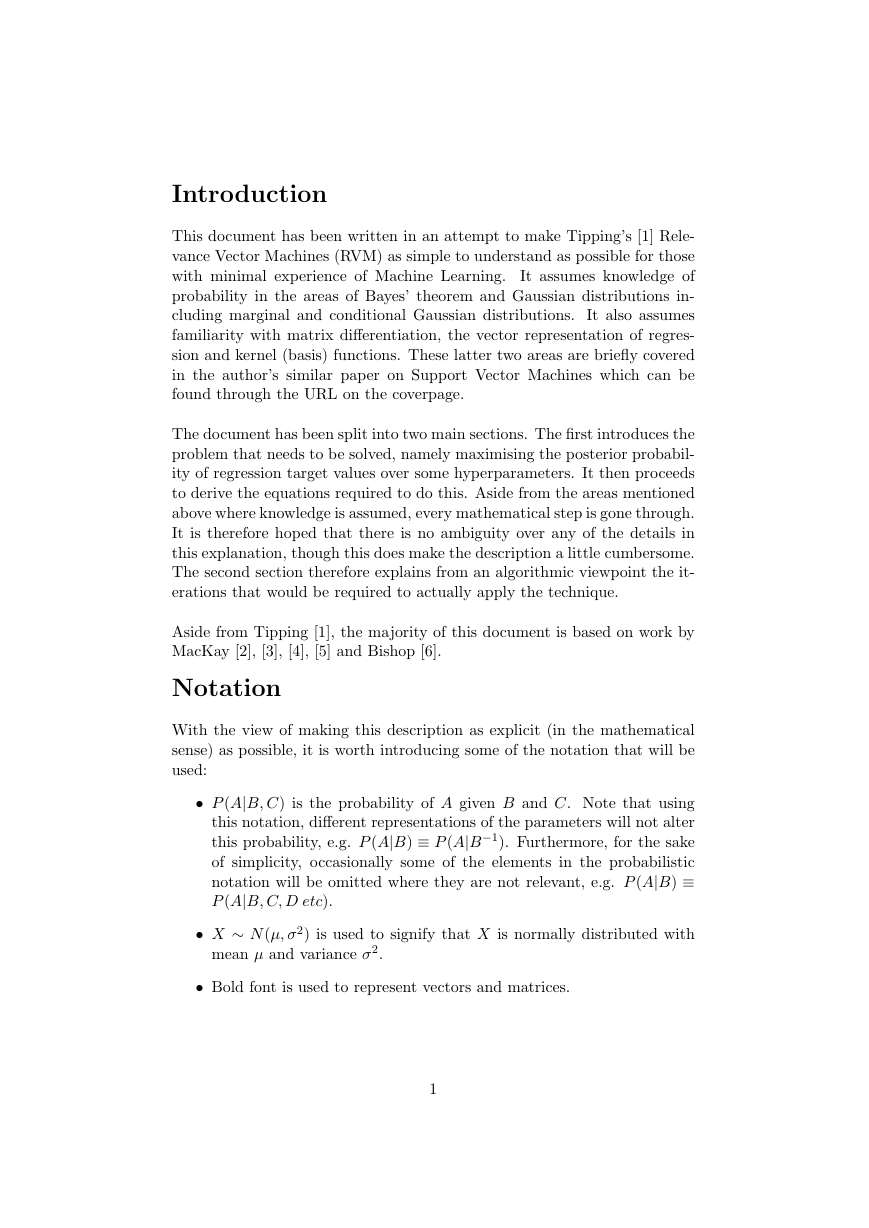
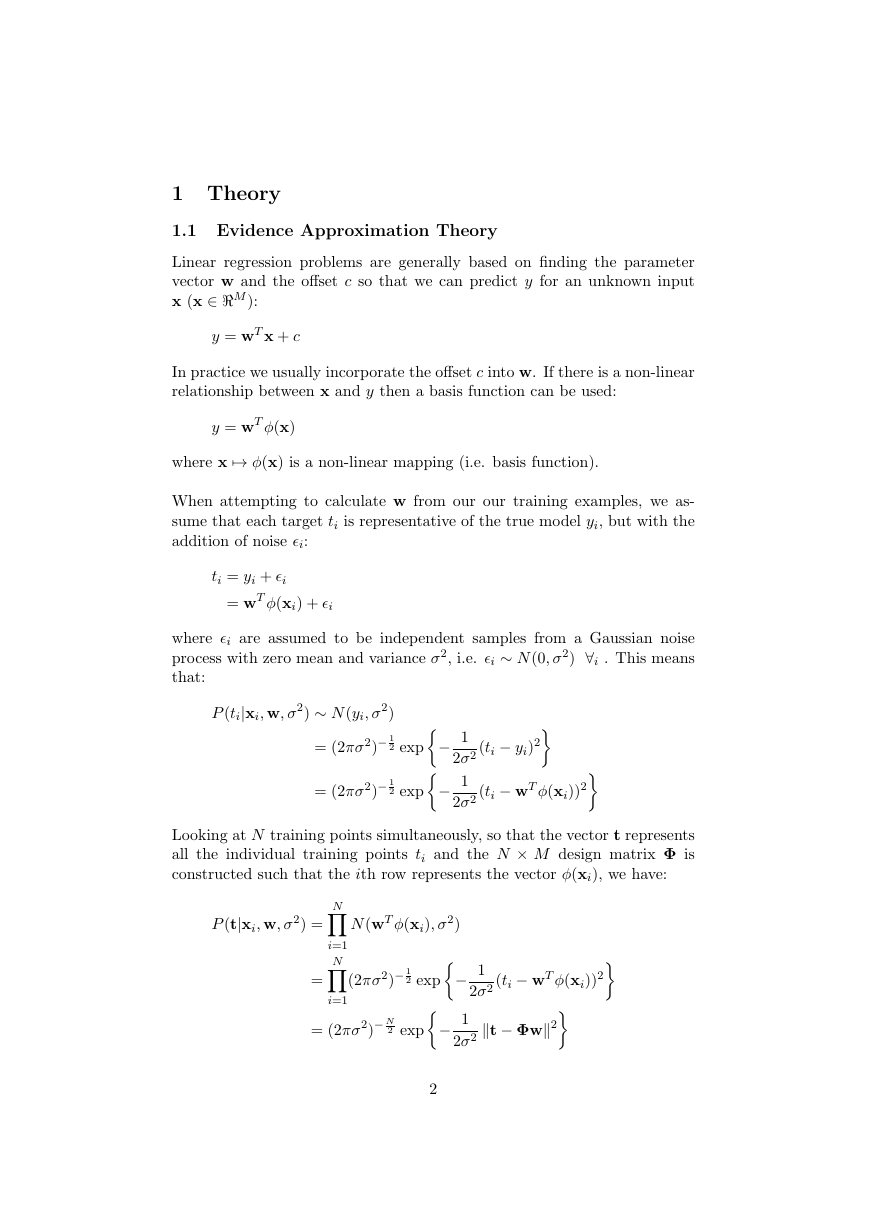
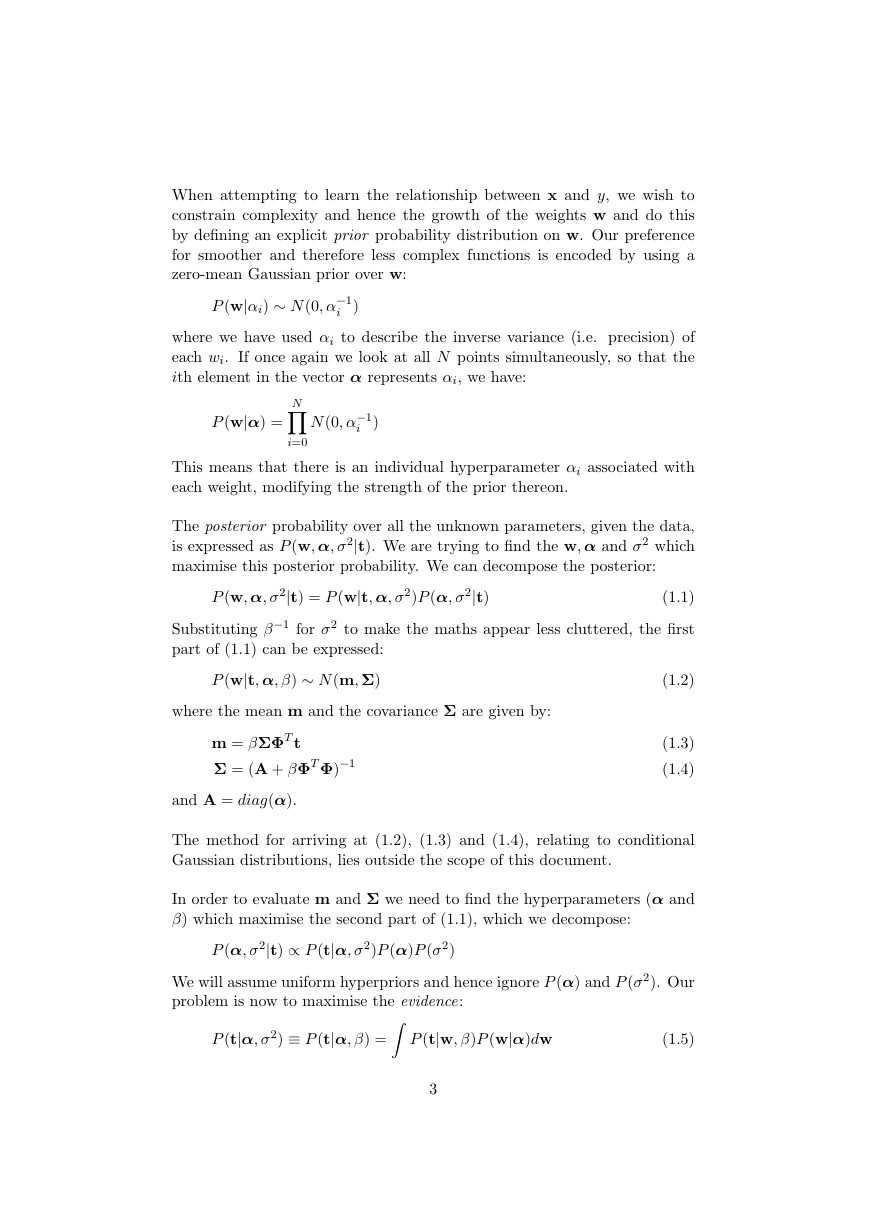
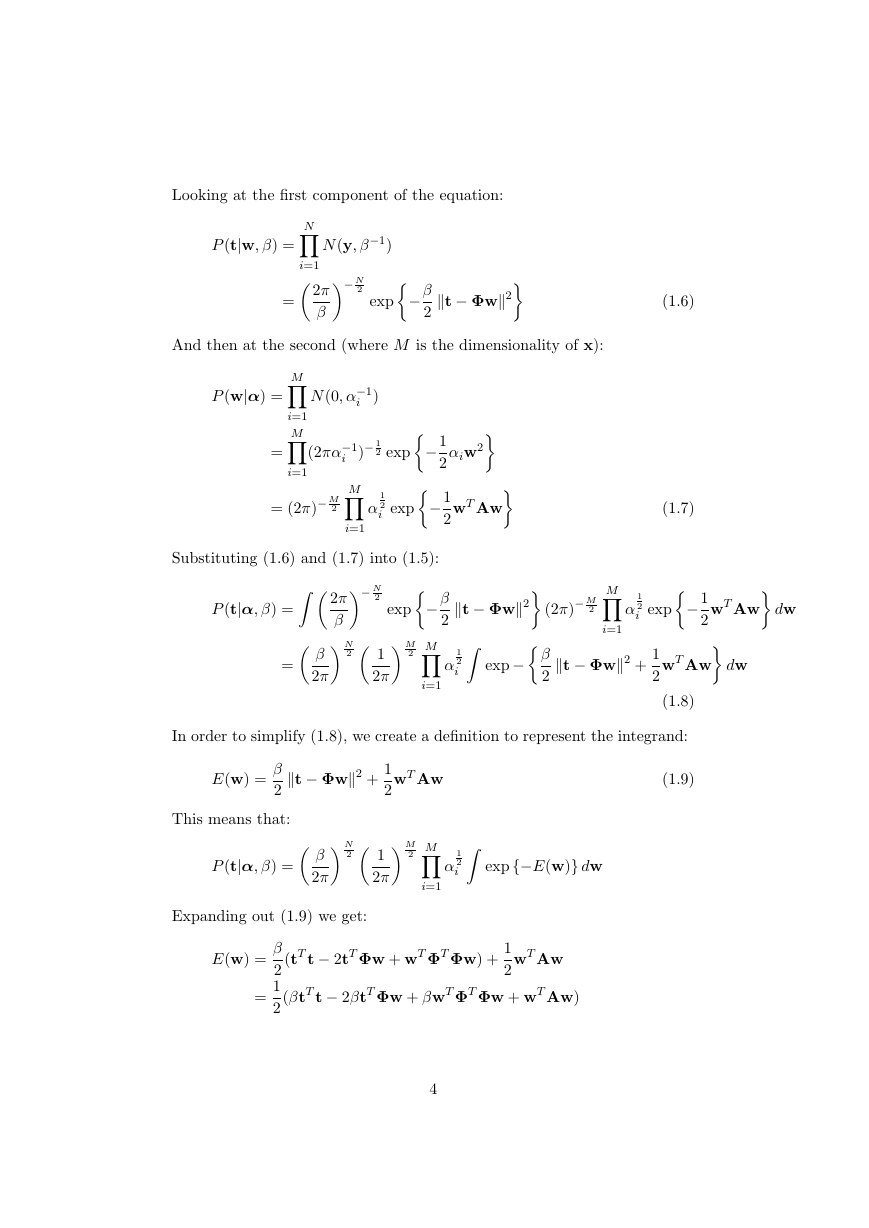
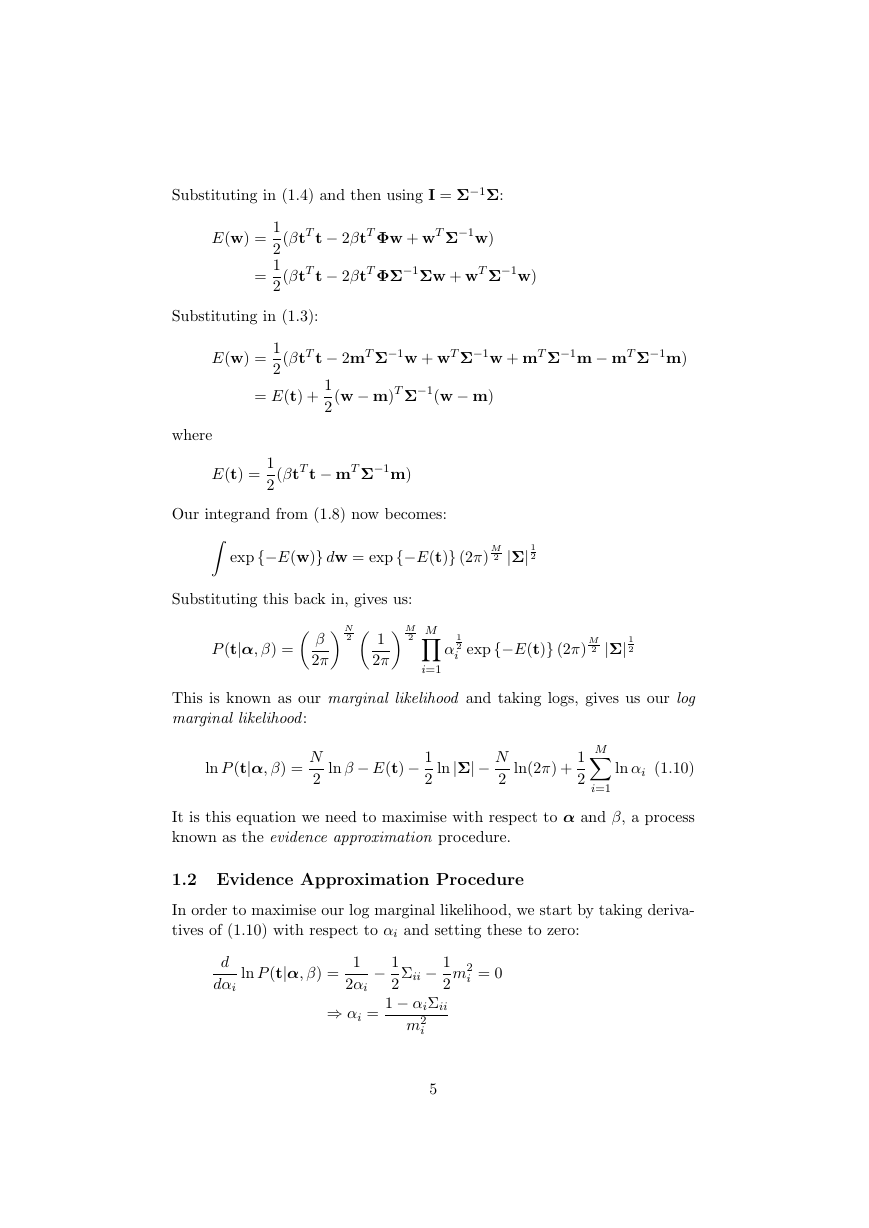
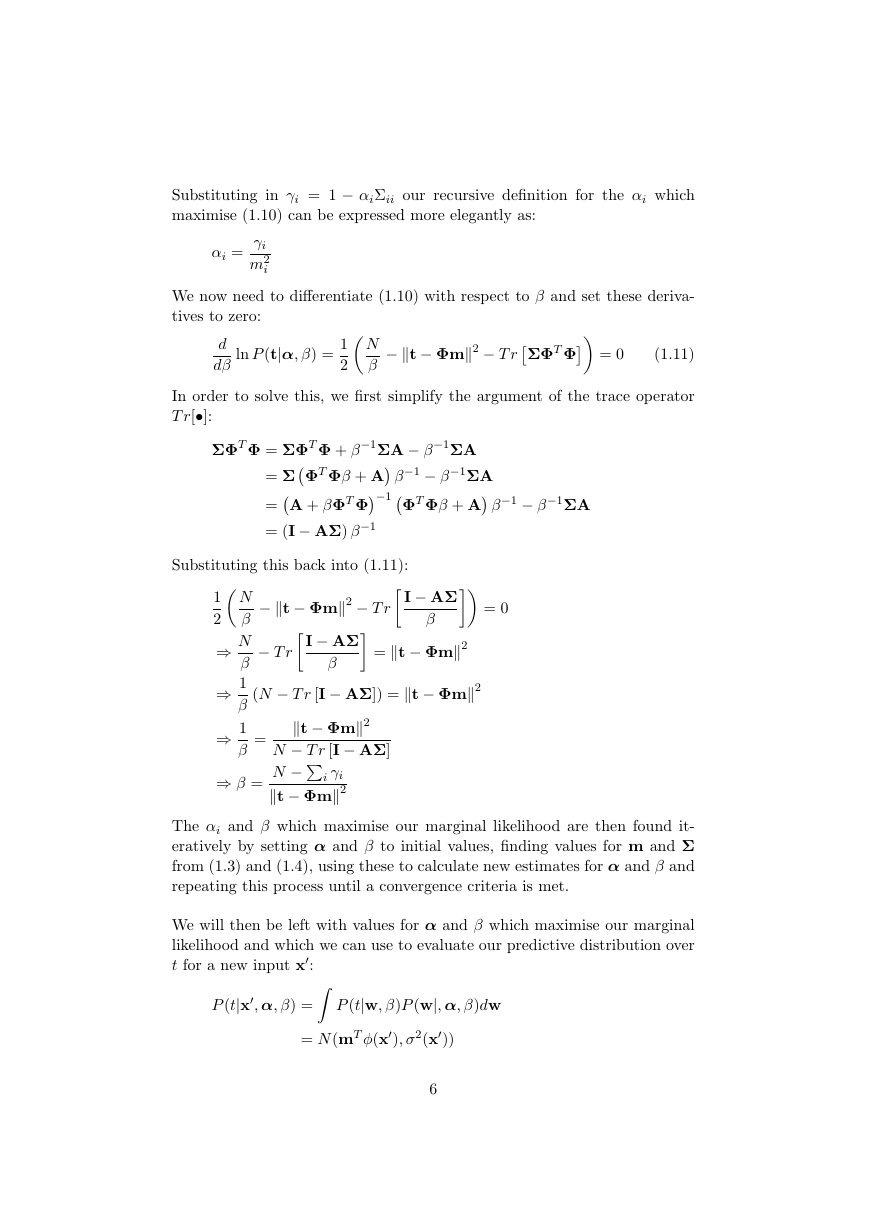
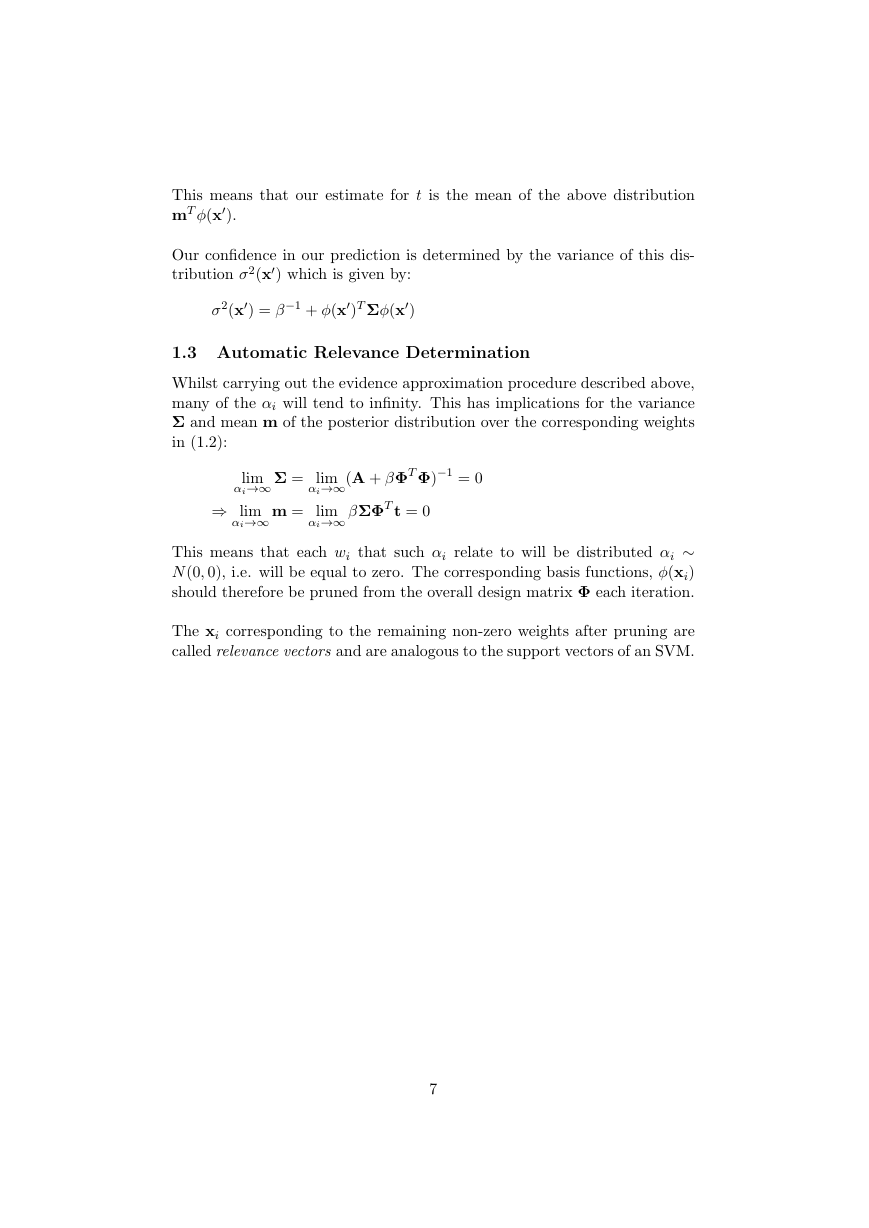








 2023年江西萍乡中考道德与法治真题及答案.doc
2023年江西萍乡中考道德与法治真题及答案.doc 2012年重庆南川中考生物真题及答案.doc
2012年重庆南川中考生物真题及答案.doc 2013年江西师范大学地理学综合及文艺理论基础考研真题.doc
2013年江西师范大学地理学综合及文艺理论基础考研真题.doc 2020年四川甘孜小升初语文真题及答案I卷.doc
2020年四川甘孜小升初语文真题及答案I卷.doc 2020年注册岩土工程师专业基础考试真题及答案.doc
2020年注册岩土工程师专业基础考试真题及答案.doc 2023-2024学年福建省厦门市九年级上学期数学月考试题及答案.doc
2023-2024学年福建省厦门市九年级上学期数学月考试题及答案.doc 2021-2022学年辽宁省沈阳市大东区九年级上学期语文期末试题及答案.doc
2021-2022学年辽宁省沈阳市大东区九年级上学期语文期末试题及答案.doc 2022-2023学年北京东城区初三第一学期物理期末试卷及答案.doc
2022-2023学年北京东城区初三第一学期物理期末试卷及答案.doc 2018上半年江西教师资格初中地理学科知识与教学能力真题及答案.doc
2018上半年江西教师资格初中地理学科知识与教学能力真题及答案.doc 2012年河北国家公务员申论考试真题及答案-省级.doc
2012年河北国家公务员申论考试真题及答案-省级.doc 2020-2021学年江苏省扬州市江都区邵樊片九年级上学期数学第一次质量检测试题及答案.doc
2020-2021学年江苏省扬州市江都区邵樊片九年级上学期数学第一次质量检测试题及答案.doc 2022下半年黑龙江教师资格证中学综合素质真题及答案.doc
2022下半年黑龙江教师资格证中学综合素质真题及答案.doc